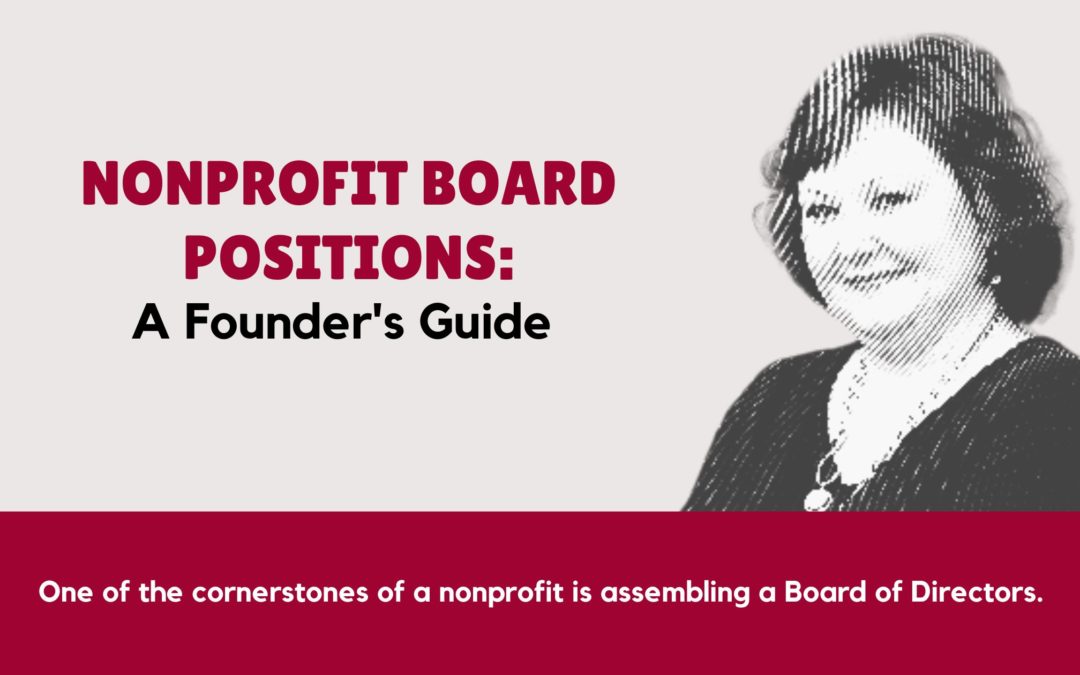Starting a nonprofit organization can be a highly fulfilling endeavor. Launching and sustaining it calls for immense hard work and commitment. One of the cornerstones of a flourishing nonprofit is assembling an able Board of Directors. As the founder, acquainting oneself with the different nonprofit Board positions and their job descriptions is vital in building a strong team. In this article, founders are guided through an overview of various nonprofit Board positions that will help establish a robust Board of Directors.
What is a Nonprofit Board of Directors?
A Board of Directors is a group of individuals that oversee the activities of an organization. In the case of a nonprofit, the Board of Directors is responsible for ensuring that the organization is fulfilling its mission and using its resources in the best possible way. Nonprofit Board positions are typically unpaid and serve in a volunteer capacity.

What Are the Different Nonprofit Board Positions?
The roles of nonprofit Board members can vary based on the organization’s scale and range. However, there are key positions that every nonprofit Board should include. These positions may differ from one another in size, scope, and complexity of their work, but they all serve a common purpose.
Chairman of the Board or President
The Chairman of the Board (also known as President) holds the most senior position on the Board of Directors. They lead and set agendas in board meetings, wielding significant power and influence over the organization.
Secretary
The Secretary is responsible for keeping accurate records of all Board meetings, including recording discussions and decisions. They are also responsible for distributing these records to all Board members.
Treasurer
The Treasurer manages the finances of the organization, including budget tracking, donation handling, and financial record-keeping.
Board members
Board members oversee the activities of nonprofit organizations. They are appointed by the Board of Directors and serve for a predetermined term.
What Are the Job Descriptions for Nonprofit Board Positions?
Nonprofit Board positions entail specific job responsibilities. However, these duties can vary based on the organization’s unique needs and structure. To provide clarity, below is a brief overview of the job descriptions for each nonprofit Board position.
The Chairman of the Board or President plays a crucial role in leading the organization’s Directors and guiding them to adhere to ethical and legal guidelines. They are responsible for ensuring that the organization operates within the constraints of the law, regulations, and ethical standards. This involves regularly reviewing and updating the organization’s policies and procedures to align with any changes in laws or regulations.
In addition to upholding ethical practices, the Chairman or President also takes charge of financial oversight. This entails overseeing the organization’s financial well-being, including budgeting, financial planning, and monitoring financial performance. They collaborate with the Board of Directors to establish and maintain a sustainable financial strategy that supports the organization’s mission and goals.
Another important responsibility of the Chairman or President is to set the strategic direction for the organization. They work closely with the Board to develop long-term goals and objectives and create a roadmap to achieve them. This involves analyzing the organization’s strengths, weaknesses, opportunities, and threats, conducting market research, and staying informed about industry trends. The Chairman or President takes the lead in shaping the strategic plan, ensuring that it aligns with the organization’s mission and vision.
The Vice President’s role is to support the President in their duties and responsibilities. One of the primary tasks of the Vice President is to step in and fulfill the duties of the President in their absence. This ensures continuity in the organization’s leadership and decision-making process. If the President cannot fulfill their duties due to illness, personal reasons, or other commitments, the Vice President takes on the role of acting President. During this time, the Vice President assumes all the responsibilities of the President, ensuring that the organization continues to function smoothly.
Additionally, the Vice President supports the President in carrying out the decisions made by the Board of Directors. This involves actively participating in Board meetings, providing input, and collaborating with the President to implement the decisions and directives of the Board. The Vice President acts as a liaison between the President and other members of the Board, ensuring effective communication and coordination.
In some cases, the Vice President may also have specific responsibilities assigned to them. These responsibilities can vary depending on the organization’s needs and structure. For example, the Vice President may oversee specific programs or committees, manage strategic initiatives, or represent the organization in external engagements. This allows the Vice President to contribute their specific expertise and help drive the organization towards its goals.
The Secretary serves a critical role in ensuring that accurate records of all Board meetings are maintained. Their primary responsibility is to document the discussions, actions, and decisions that take place during these meetings. As the official record keeper, the Secretary’s role is to create detailed meeting minutes that capture the essence of the discussions and accurately reflect the decisions made.
This task requires the Secretary to possess strong listening and note-taking skills. They must actively listen to the discussions and conversations during the meeting, accurately capturing key points, arguments, and important background information. The Secretary should also be proficient in organizing and summarizing information, as they need to distill a wealth of conversation into clear and concise meeting minutes.
After the meeting, the Secretary is responsible for finalizing and distributing the meeting minutes to all Board members. By promptly sharing the minutes, the Secretary ensures that all Board members are informed of the decisions, actions, and discussions. This promotes transparency and accountability within the organization, allowing Board members to remain updated and engaged.
In addition to meeting minutes, the Secretary may also be responsible for maintaining other important records, such as the organization’s bylaws, policies, and other legal documents. They must ensure these documents are accurate, up-to-date, and easily accessible to Board members and relevant stakeholders.
The Secretary’s attention to detail is crucial to the role, as they must accurately document the proceedings of the Board meetings. This includes capturing important details such as who was present at the meeting, the date and time of the meeting, and any motions or resolutions passed during the deliberations. Their records serve as evidence of the Board’s decisions and as a reference point for future discussions and planning.
Furthermore, the Secretary may play a broader role in coordinating and managing Board communications. This can involve organizing and sending meeting invitations, agendas, and other relevant documents, as well as maintaining communication channels between Board members and organizing regular updates or reports from committee chairs or other relevant parties.
Overall, the Secretary is an essential position within a nonprofit board, responsible for creating accurate and reliable records of Board meetings. Their attention to detail, organizational skills, and effective communication contribute to the smooth functioning of the Board while maintaining transparency, accountability, and continuity within the organization.
The Treasurer holds a vital position within the organization, responsible for managing its finances and ensuring financial stability. Their role encompasses various tasks related to budgeting, monitoring donations and grants, and managing investments.
One of the primary responsibilities of the Treasurer is overseeing the organization’s budget. They work closely with the Board of Directors and other relevant stakeholders to develop an annual budget that aligns with the organization’s mission, goals, and financial capabilities. This involves analyzing past financial data, projecting future expenses and revenue, and making informed decisions on resource allocation. The Treasurer helps the organization achieve its financial objectives and efficiently use its resources through effective budget management.
Monitoring donations and grants is another aspect of the Treasurer’s role. They are responsible for recording and tracking all incoming funds, ensuring accurate and transparent financial documentation. They work closely with the fundraising team to monitor donation transactions, update donor records, and acknowledge contributions in a timely manner. Additionally, the Treasurer may collaborate with grant writers and program staff to oversee the financial aspects of grant applications and reports, ensuring compliance with grant requirements.
The Treasurer also plays a role in managing investments on behalf of the organization. They evaluate investment opportunities, assess risks, and recommend investment strategies to the Board of Directors. The Treasurer keeps a keen eye on the organization’s investments, regularly monitoring their performance and ensuring alignment with the organization’s financial goals and risk tolerance. They may work with financial advisors or investment managers to make informed investment decisions that safeguard the organization’s financial stability.
The role of the Treasurer is not limited to financial management alone; they also provide financial oversight to the organization. This involves reviewing and analyzing financial statements, reports, and transactions to ensure accuracy, compliance, and accountability. The Treasurer may collaborate with an external accountant or audit team to conduct regular financial audits and ensure adherence to accounting standards and legal requirements.
Board members play a vital role in overseeing the activities of a nonprofit organization. Their responsibilities are broad and encompass various key aspects of governance, decision-making, and strategic planning.
First and foremost, attending Board meetings is a fundamental responsibility of every Board member. Regular attendance ensures active participation, collaboration, and collective decision-making. Board meetings serve as a platform for discussing important matters, receiving updates on organizational progress, and making critical decisions that align with the organization’s mission and goals.
Reviewing financial reports is another significant responsibility of Board members. They are entrusted with ensuring the financial health and sustainability of the organization. By regularly reviewing financial statements, reports, and audits, Board members gain insight into the organization’s financial standing, identify any potential risks or challenges, and make informed decisions related to budgeting, fundraising, and resource allocation. This financial oversight helps maintain transparency, accountability, and the trust of stakeholders.
Board members actively vote on important matters that require Board approval. This may include decisions related to major organizational changes, annual budgets, key policies, hiring or dismissal of senior executives, or significant programmatic initiatives. Voting ensures that decisions are made collectively, taking into consideration diverse perspectives and in the best interest of the organization and its stakeholders.
Participating in strategic planning is another crucial responsibility of Board members. They play a pivotal role in shaping the organization’s long-term vision, goals, and strategies. By collaborating with other Board members and organizational leadership, they contribute their expertise and insights to develop strategic plans that drive the organization forward. This may involve conducting market research, analyzing trends, and considering opportunities and challenges in order to align the organization’s mission with its sustainable growth and impact.
Board members also have a fiduciary duty to the organization, which entails acting in the organization’s best interest, ensuring good governance practices, and safeguarding its assets. They may review and approve organizational policies, establish internal controls, and monitor compliance with relevant laws, regulations, and ethical standards. Additionally, they may contribute to fundraising efforts, advocacy initiatives, or engagement with key stakeholders to support the organization’s mission and advance its impact on the community.
Overall, the role of a Board member is multifaceted and requires a commitment to the organization’s mission, active engagement, and effective collaboration with other Board members and organizational leadership. Board members ensure the nonprofit organization’s effective governance and continuous advancement through their oversight, decision-making, and strategic contributions.

Becoming a nonprofit Board member doesn’t require any formal qualifications. However, there are particular skills and qualities that one must possess to become an effective Board member. These vital traits include:
- Board members of a nonprofit should have professional experience relevant to the organization’s mission. If the nonprofit focuses on providing healthcare services, its Board members should have worked in healthcare.
- Board members should possess financial management skills. This includes experience in budgeting, financial planning, and fundraising.
- Board members are expected to possess strategic planning skills, which involve their ability to create and execute plans that enable them to achieve predetermined goals and objectives. This requires proven expertise in developing actionable strategies and monitoring progress towards those aims continuously improving.
- Board members should be strongly committed to the nonprofit’s mission and willing to devote time and resources to help the organization succeed.
What Are the Responsibilities of Nonprofit Board Members?
Nonprofit Board members have several key responsibilities, including:
Oversee and Review the Organization’s Performance
Board members are responsible for overseeing the nonprofit organization’s activities. This includes reviewing financial reports, monitoring the progress of programs and services, and ensuring
Board members are responsible for reviewing the organization’s performance regularly and ensuring that it is accountable for delivering transparent results to stakeholders. This involves effective evaluation mechanisms that support maximum output from the organization while keeping everyone informed on its overall progress.
Alignment of Mission and Operations
Board members of a nonprofit have the responsibility to ensure its operations align with the organization’s mission and vision. They are accountable for reviewing and approving strategic plans, programs, policies, budgets, and activities. This helps the nonprofit maintain focus on achieving their goals efficiently.
Financial Management
Board members are responsible for ensuring that their nonprofit organization’s finances are appropriately managed. This involves overseeing accurate financial record-keeping, asset management, and budget creation aligned with the organizational goals to ensure efficient and effective financial management.
Hiring and Overseeing the Executive Director
Board members of a nonprofit are responsible for hiring and overseeing the CEO or Executive Director. This includes providing support, guidance, and reviewing their performance.
Legal Compliance
Ensure compliance with regulations and laws: Board members must ensure that the nonprofit complies with all legal and regulatory requirements, including tax filings, accounting standards, employment laws, and safety regulations.
Financial Stability
Board members are essential contributors to the organization’s financial sustainability through fundraising and resource development. They should actively participate in identifying and cultivating potential individual or corporate donors, sponsorships, or grants.
Serve as Ambassadors
Board members must wear multiple hats by serving as ambassadors. Among other roles that include leadership, decision-making, and strategy development, they are also expected to be the organization’s representatives. They are responsible for advocating for its mission and accomplishments beyond organizational constraints. They should build strong relationships with stakeholders such as supporters, donors,
Strategic Planning
Board members are responsible for shaping the overall direction and strategy of the nonprofit, setting ambitious goals, and monitoring progress toward the target.
In summary, members of nonprofit boards shoulder a significant responsibility to foster social good by practicing good governance, maintaining financial stability, and making strategic decisions. Their unwavering dedication and commitment serve as the backbone for not-for-profit organizations’ long-term success and sustainability.
FAQ
What is the structure of a nonprofit board of directors?
The structure of a nonprofit board of directors typically includes a group of individuals responsible for governing and guiding the organization. It usually consists of a president, vice president, secretary, treasurer, and general board members who oversee decision-making and strategic planning to fulfill the nonprofit’s mission.
What are the responsibilities of a nonprofit board?
The responsibilities of a nonprofit board include governance oversight, strategic planning, financial stewardship, and ensuring the organization’s mission is fulfilled.
What are the three basic legal duties of a nonprofit board member?
The three basic legal duties of a nonprofit board member are:
1. Duty of Care: The responsibility to make informed and prudent decisions, acting in the organization’s best interest.
2. Duty of Loyalty: Obligation to prioritize the interests of the nonprofit, avoiding conflicts of interest, and acting in good faith.
3. Duty of Obedience: Ensuring that the organization operates within its mission and complies with all applicable laws and regulations.
What is the difference between a nonprofit board chair and a board president?
The nonprofit board chair and board president are typically the same roles, with different titles. They both serve as the head of the board of directors, providing leadership and overseeing the organization’s governance and strategic direction.
How to Find Nonprofit Board Member Positions?
To find nonprofit board member positions, consider networking within your community, engaging with nonprofit organizations, attending board member orientation sessions, and utilizing online resources like nonprofit job boards and LinkedIn.



